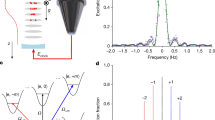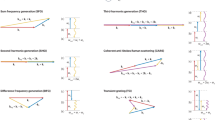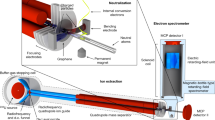Abstract
Einstein predicted that clocks at different altitudes tick at various rates under the influence of gravity. This effect has been observed using 57Fe Mössbauer spectroscopy over an elevation of 22.5 m (ref. 1) or by comparing accurate optical clocks at different heights on a submetre scale2. However, challenges remain in finding novel methods for the detection of gravitational and relativistic effects on more compact scales. Here, we investigate a scheme that potentially allows for millimetre- to submillimetre-scale studies of the gravitational redshift by probing a nuclear crystal with X-rays. Also, a rotating crystal can force interacting X-rays to experience inhomogeneous clock tick rates within it. We find that an association of gravitational redshift and special-relativistic time dilation with quantum interference is manifested by a time-dependent deflection of X-rays. The scheme suggests a table-top solution for probing gravitational and special-relativistic effects, which should be within the reach of current experimental technology3,4,5.
This is a preview of subscription content, access via your institution
Access options
Subscribe to this journal
Receive 12 print issues and online access
$209.00 per year
only $17.42 per issue
Buy this article
- Purchase on Springer Link
- Instant access to full article PDF
Prices may be subject to local taxes which are calculated during checkout



Similar content being viewed by others
References
Pound, R. V. & Rebka, G. A. Apparent weight of photons. Phys. Rev. Lett. 4, 337–341 (1960).
Chou, C. W., Hume, D. B., Rosenband, T. & Wineland, D. Optical clocks and relativity. Science 329, 1630–1633 (2010).
Altarelli, M. et al. XFEL: The European X-Ray Free-Electron Laser. Technical Design Report (DESY, 2006).
Röhlsberger, R. Nuclear Condensed Matter Physics with Synchrotron Radiation: Basic Principles, Methodology and Applications (Springer-Verlag, 2004).
Shvyd'ko, Y. X-Ray Optics: High-Energy-Resolution Applications (Springer-Verlag, 2004).
Shvyd'ko, Y., Stoupin, S., Blank, V. & Terentyev, S. Near-100% Bragg reflectivity of X-rays. Nature Photon. 5, 539–542 (2011).
Adams, B. W. et al. X-ray quantum optics. J. Mod. Opt. 60, 2–21 (2013).
Glover, T. et al. Controlling X-rays with light. Nature Phys. 6, 69–74 (2010).
Rohringer, N. et al. Atomic inner-shell X-ray laser at 1.46 nanometres pumped by an X-ray free-electron laser. Nature 481, 488–491 (2012).
Vagizov, F., Antonov, V., Radeonychev, Y., Shakhmuratov, R. & Kocharovskaya, O. Coherent control of the waveforms of recoilless γ-ray photons. Nature 508, 80–83 (2014).
Röhlsberger, R., Wille, H.-C., Schlage, K. & Sahoo, B. Electromagnetically induced transparency with resonant nuclei in a cavity. Nature 482, 199–203 (2012).
Röhlsberger, R., Schlage, K., Sahoo, B., Couet, S. & Rüffer, R. Collective Lamb shift in single-photon superradiance. Science 328, 1248–1251 (2010).
Heeg, K. P. et al. Vacuum-assisted generation and control of atomic coherences at X-ray energies. Phys. Rev. Lett. 111, 073601 (2013).
Liao, W.-T., Pálffy, A. & Keitel, C. H. Coherent storage and phase modulation of single hard-X-ray photons using nuclear excitons. Phys. Rev. Lett. 109, 197403 (2012).
Cavaletto, S. M. et al. Broadband high-resolution X-ray frequency combs. Nature Photon. 8, 520–523 (2014).
Shvyd'ko, Y. V. et al. Storage of nuclear excitation energy through magnetic switching. Phys. Rev. Lett. 77, 3232–3235 (1996).
Hay, H. J., Schiffer, J. P., Cranshaw, T. E. & Egelstaff, P. A. Measurement of the red shift in an accelerated system using the Mössbauer effect in Fe57. Phys. Rev. Lett. 4, 165–166 (1960).
Ives, H. E. & Stilwell, G. An experimental study of the rate of a moving atomic clock. J. Opt. Soc. Am. 28, 215–219 (1938).
Reinhardt, S. et al. Test of relativistic time dilation with fast optical atomic clocks at different velocities. Nature Phys. 3, 861–864 (2007).
Campbell, C. J. et al. Single-ion nuclear clock for metrology at the 19th decimal place. Phys. Rev. Lett. 108, 120802 (2012).
Derevianko, A., Dzuba, V. A. & Flambaum, V. V. Highly charged ions as a basis of optical atomic clockwork of exceptional accuracy. Phys. Rev. Lett. 109, 180801 (2012).
Pikovski, I., Vanner, M. R., Aspelmeyer, M., Kim, M. S. & Brukner, Č. Probing Planck-scale physics with quantum optics. Nature Phys. 8, 393–397 (2012).
Scully, M. O., Fry, E. S., Ooi, C. H. R. & Wódkiewicz, K. Directed spontaneous emission from an extended ensemble of N atoms: Timing is everything. Phys. Rev. Lett. 96, 010501 (2006).
Dressel, J., Rajeev, S. G., Howell, J. C. & Jordan, A. N. Gravitational redshift and deflection of slow light. Phys. Rev. A 79, 013834 (2009).
Karpa, L. & Weitz, M. A Stern–Gerlach experiment for slow light. Nature Phys. 2, 332–335 (2006).
Kazakov, G. et al. Performance of a 229thorium solid-state nuclear clock. New J. Phys. 14, 083019 (2012).
Maurer, P. C. et al. Room-temperature quantum bit memory exceeding one second. Science 336, 1283–1286 (2012).
Heinze, G., Hubrich, C. & Halfmann, T. Stopped light and image storage by electromagnetically induced transparency up to the regime of one minute. Phys. Rev. Lett. 111, 033601 (2013).
Neu, E. et al. Single photon emission from silicon-vacancy colour centres in chemical vapour deposition nano-diamonds on iridium. New J. Phys. 13, 025012 (2011).
2014 Nuclear Structure and Decay Databases. (National Nuclear Data Center, 2014); http://www.nndc.bnl.gov/nudat2/indx_adopted.jsp
Acknowledgements
The authors thank C.H. Keitel, A. Pálffy, Z. Harman, E. Yakaboylu, S.M. Cavaletto, C. O'Brien, K. Heeg, M. Gärttner, T. Babinec, P. Hemmer and A. Svidzinsky for valuable discussions.
Author information
Authors and Affiliations
Contributions
W.-T.L. and S.A. contributed equally to this work.
Corresponding author
Ethics declarations
Competing interests
The authors declare no competing financial interests.
Supplementary information
Supplementary information
Supplementary information (PDF 1126 kb)
Rights and permissions
About this article
Cite this article
Liao, WT., Ahrens, S. Gravitational and relativistic deflection of X-ray superradiance. Nature Photon 9, 169–173 (2015). https://doi.org/10.1038/nphoton.2015.7
Received:
Accepted:
Published:
Issue Date:
DOI: https://doi.org/10.1038/nphoton.2015.7
This article is cited by
-
Resonant X-ray excitation of the nuclear clock isomer 45Sc
Nature (2023)
-
An inverse free electron laser acceleration-driven Compton scattering X-ray source
Scientific Reports (2019)
-
Optomechanically induced transparency of x-rays via optical control
Scientific Reports (2017)
-
Controllable vacuum-induced diffraction of matter-wave superradiance using an all-optical dispersive cavity
Scientific Reports (2016)
-
Gravity meets quantum physics
Nature Photonics (2015)



